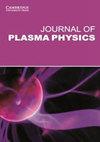A two-dimensional numerical study of ion-acoustic turbulence
IF 2.5
3区 物理与天体物理
Q2 PHYSICS, FLUIDS & PLASMAS
引用次数: 0
Abstract
We investigate the linear and nonlinear evolution of the current-driven ion-acoustic instability in a collisionless plasma via two-dimensional (2-D) Vlasov–Poisson numerical simulations. We initialise the system in a stable state and gradually drive it towards instability with an imposed, weak external electric field, thus avoiding physically unrealisable super-critical initial conditions. A comprehensive analysis of the nonlinear evolution of ion-acoustic turbulence (IAT) is presented, including the detailed characteristics of the evolution of the particles’ distribution functions, (2-D) wave spectrum and the resulting anomalous resistivity. Our findings reveal the dominance of 2-D quasi-linear effects around saturation, with nonlinear effects, such as particle trapping and nonlinear frequency shifts, becoming pronounced during the later stages of the system's nonlinear evolution. Remarkably, the Kadomtsev–Petviashvili (KP) spectrum is observed immediately after the saturation of the instability. Another crucial and noteworthy result is that no steady saturated nonlinear state is ever reached: strong ion heating suppresses the instability, which implies that the anomalous resistivity associated with IAT is transient and short-lived, challenging earlier theoretical results. Towards the conclusion of the simulation, electron-acoustic waves are triggered by the formation of a double layer and strong modifications to the particle distribution induced by IAT.离子声湍流的二维数值研究
我们通过二维(2-D)弗拉索夫-泊松数值模拟研究了无碰撞等离子体中电流驱动离子声不稳定性的线性和非线性演变。我们将系统初始化为稳定状态,并通过强加的弱外部电场使其逐渐走向不稳定,从而避免了物理上不可行的超临界初始条件。我们对离子声湍流(IAT)的非线性演变进行了全面分析,包括粒子分布函数、(2-D)波谱和由此产生的反常电阻率演变的详细特征。我们的研究结果表明,二维准线性效应在饱和附近占主导地位,而非线性效应,如粒子捕获和非线性频率偏移,在系统非线性演变的后期阶段变得非常明显。值得注意的是,卡多姆采夫-彼得维亚什维利(KP)谱在不稳定性饱和后立即出现。另一个关键且值得注意的结果是,系统并没有达到稳定的饱和非线性状态:强烈的离子加热抑制了不稳定性,这意味着与 IAT 相关的异常电阻率是瞬时和短暂的,这对之前的理论结果提出了挑战。在模拟接近尾声时,双层的形成和 IAT 引起的粒子分布的强烈变化引发了电子声波。
本文章由计算机程序翻译,如有差异,请以英文原文为准。
求助全文
约1分钟内获得全文
求助全文
来源期刊

Journal of Plasma Physics
物理-物理:流体与等离子体
CiteScore
3.50
自引率
16.00%
发文量
106
审稿时长
6-12 weeks
期刊介绍:
JPP aspires to be the intellectual home of those who think of plasma physics as a fundamental discipline. The journal focuses on publishing research on laboratory plasmas (including magnetically confined and inertial fusion plasmas), space physics and plasma astrophysics that takes advantage of the rapid ongoing progress in instrumentation and computing to advance fundamental understanding of multiscale plasma physics. The Journal welcomes submissions of analytical, numerical, observational and experimental work: both original research and tutorial- or review-style papers, as well as proposals for its Lecture Notes series.
 求助内容:
求助内容: 应助结果提醒方式:
应助结果提醒方式:


